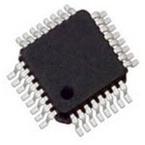●The medium-density STM8AL313x/4x/6x and STM8AL3L4x/6x devices are members of the STM8AL automotive ultra-low-power 8-bit family. The medium-density STM8AL3xxx family operates from 1.8 V to 3.6 V (down to 1.65 V at power down) and is available in the -40 to +85°C and -40 to +125°C temperature ranges.
●The medium-density STM8AL3xxx ultra-low-power family features the enhanced STM8 CPU core providing increased processing power (up to 16 MIPS at 16 MHz) while maintaining the advantages of a CISC architecture with improved code density, a 24-bit linear addressing space and an optimized architecture for low power operations.
●The family includes an integrated debug module with a hardware interface (SWIM) which allows non-intrusive In-Application debugging and ultrafast Flash programming.
●All medium-density STM8AL3xxx microcontrollers feature embedded data EEPROM and low power low-voltage single-supply program Flash memory.
●They incorporate an extensive range of enhanced I/Os and peripherals.
●The modular design of the peripheral set allows the same peripherals to be found in different ST microcontroller families including 32-bit families. This makes any transition to a different family very easy, and simplified even more by the use of a common set of development tools.
●Two different packages are proposed which include 32 and 48 pins. Depending on the device chosen, different sets of peripherals are included.
●All STM8AL3xxx ultra-low-power products are based on the same architecture with the same memory mapping and a coherent pinout
●Key Features
● AEC-Q100 qualified
● Operating conditions
● Operating power supply range 1.8 V to 3.6 V (down to 1.65 V at power down)
● Temperature range: - 40 °C to 85 or 125 °C
● Low power features
● Five low-power modes: Wait, low-power run (5.1 μA), low-power wait (3 μA), active-halt with full RTC (1.3 μA), halt with PDR (400 nA)
● Run from Flash: 195 μA/MHz + 440 μA
● Run from RAM: 90 μA/MHz + 400 μA
● Ultra-low leakage per I/0: 50 nA
● Fast wakeup from Halt: 4.7 μs
● Advanced STM8 core
● Harvard architecture and 3-stage pipeline
● Max freq. 16 MHz, 16 CISC MIPS peak
● Up to 40 external interrupt sources
● Reset and supply management
● Low power, ultra safe BOR reset with 5 selectable thresholds
● Ultra-low power POR/PDR
● Programmable voltage detector (PVD)
● Clock management
● 1 to 16 MHz crystal oscillator
● 32 kHz crystal oscillator
● Internal 16 MHz factory-trimmed RC
● Internal 38 kHz low consumption RC
● Clock security system
● Low power RTC
● BCD calendar with alarm interrupt
● Auto-wakeup from Halt (0.95 ppm resolution) w/ periodic interrupt
● LCD: up to 4x28 segments w/ step-up converter
● Memories
● Program memory: up to 32 Kbyte Flash program; data retention 20 years at 55 °C
● Data memory: up to 1 Kbyte true data EEPROM; endurance 300 kcycle
● RAM: up to 2 Kbyte
● DMA
● Four channels; supported peripherals: ADC, DAC, SPI, I2C, USART, timers
● One channel for memory-to-memory
● 12-bit DAC with output buffer
● 12-bit ADC up to 1 Mbps/25 channels
● Temp sensor and internal reference voltage
● Two ultra-low-power comparators
● One with fixed threshold and one rail to rail
● Wakeup capability
● Timers
● Two 16-bit timers with two channels (used as IC, OC, PWM), quadrature encoder
● One 16-bit advanced control timer with three channels, supporting motor control
● One 8-bit timer with 7-bit prescaler
● Two watchdogs: one window, one independent
● Beeper timer with 1-, 2- or 4 kHz frequencies
● Communication interfaces
● Synchronous serial interface (SPI)
● Fast I2C 400 kHz SMBus and PMBus
● USART (ISO 7816 interface, IrDA, LIN 1.3, LIN 2.0)
● Up to 41 I/Os, all mappable on interrupt vectors
● Development support
● Fast on-chip programming and non intrusive debugging with SWIM
● Bootloader using USART
● 96-bit unique ID

 Part 3D Model
Part 3D Model
